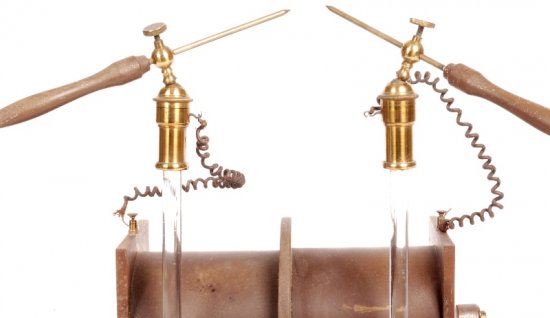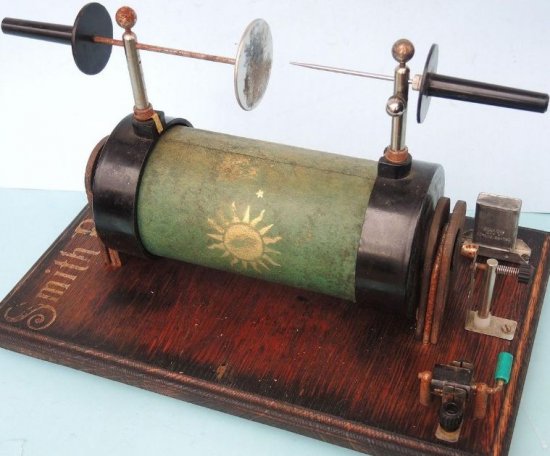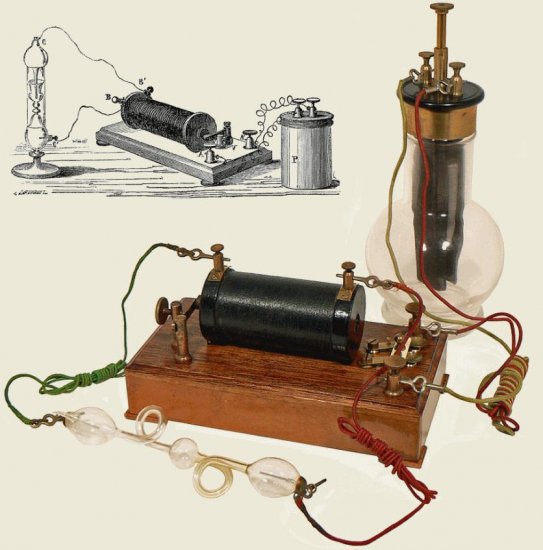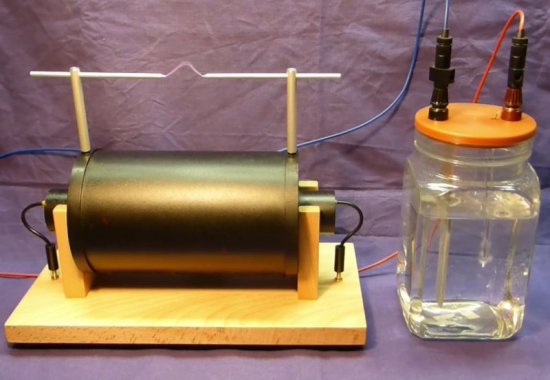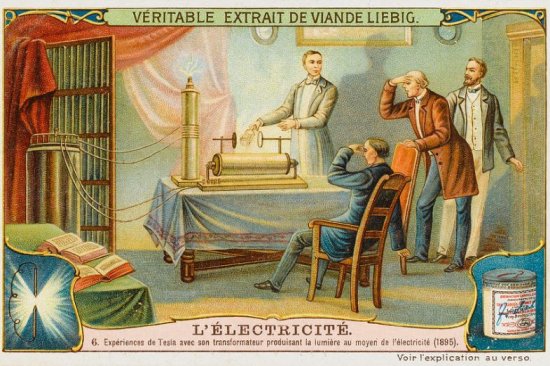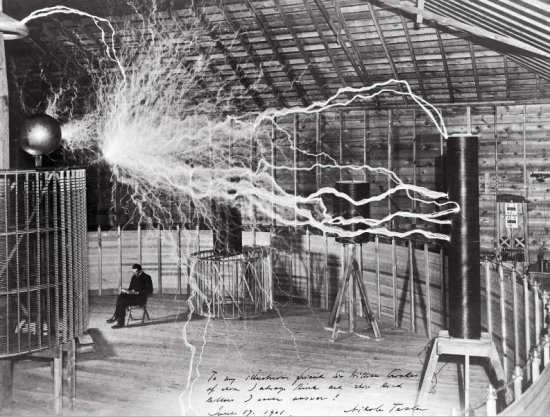Devices for receiving high voltage alternating current pulses: Rumkorff coil and Tesla transformer
Technical devices for receiving high voltage
At the beginning of the 19th century, scientists began to create devices for obtaining high voltages of alternating current. Heinrich Hertz in his experiments used the devices that were already available at that time in physical experimental science and in electrical engineering.
These were very characteristic devices in which phenomena known in physics were used, and above all, self-induction — the appearance of an induced electromotive force in coils with an iron core at the moment of a sharp increase or rapid interruption of the electric current passing through the loops.
In the 1930s. the first electric machines appeared, based on the crossing of magnetic lines of force by means of rotating coils. The first such machines (1832) were the generators of I. Pixii, A. Jedlik, B. Jacobi, D. Henry.
A very important event in physics and emerging electrical engineering was the appearance of induction machines, which were actually high-voltage transformers.
These were electromagnets with two coils. The current in the first coil is interrupted periodically in one way or another, while an induced current appears in the second coil (more precisely, EMF of self-induction). The first "transformers" that found practical use had an open-loop magnetic system. They belong to the 70s and 80s of the 19th century, and their appearance is associated with the names of P. Yablochkov, I. Usagin, L. Golyar, E. Gibbs and others.
In 1837, induction machines or "coils" appeared, created by the French professor Antoine Masson. These machines operated with a quick power cut. A switch in the form of a gear was used, which during rotation touched the metal brush at regular intervals. The interruption of the current led to self-induction EMF, and high-voltage pulses with a sufficiently high frequency appeared at the output of the machine. Masson uses this machine for medical purposes.
Rumkorf induction coil
In 1848, the famous master of physical devices Heinrich Rumkorff (who had a workshop in Paris for the manufacture of apparatus for physical experiments) noticed that the tension in Masson's machine could be increased significantly if the coil was made with a large number of turns and the frequency of interruptions increases significantly.
In 1852 he designed a coil with two coils: one with thick wire and a small number of turns, the other with thin wire and a very large number of turns. The primary coil is powered by a battery through a vibrating magnetic switch, while a high voltage is induced in the secondary.This coil became known as "induction" and was named after its creator Rumkorf.
It was a very useful physical device needed to conduct experiments, and later became an integral part of the first radio systems and X-ray machines. The Paris Academy of Sciences highly appreciated Rumkorff's merit and awarded him a large monetary prize in the name of Volta.
A little earlier (in 1838), the American engineer Charles Page, who was also involved in improving induction coils, achieved good results — his devices gave quite high voltages. In Europe, however, nothing was known about Page's work and research here continued on an independent path.
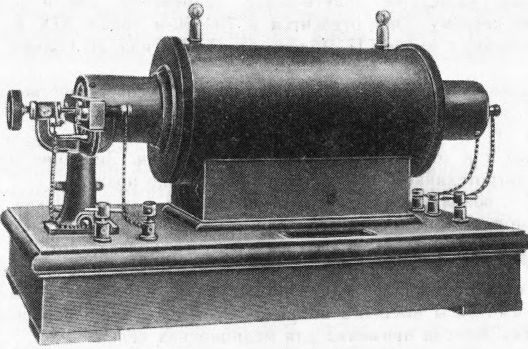
Rumkorf reel (1960s)
If the first models of induction coils gave a voltage that caused sparks about 2 cm long, then in 1859 L. Ritchie obtained sparks up to 35 cm long and Rumkorff soon built an induction coil with sparks up to 50 cm long.
The Rumkorf induction coil has survived almost without fundamental changes. Only the dimensions of the coils, insulation, etc. have been changed. The biggest changes affect the construction and principles of operation of the circuit breakers in the primary circuit of the induction coil.
Rumkorf coils
One of the first types of circuit breakers used in Rumkorf coils was the so-called "Wagner hammer" or "Neff hammer". This very interesting device appeared around the 1840s. and was an electromagnet powered by a battery via a movable ferromagnetic lobe with contacts.
When the device was turned on, the petal was attracted to the core of the electromagnet, the contact interrupted the supply circuit of the electromagnet, after which the petal moved away from the core to its original position. The process is then repeated at a frequency determined by the size of the system parts, the stiffness and mass of the petal, and a number of other factors.
The Wagner-Nef device later became the electric bell and was one of the first electromechanical oscillating systems that became the prototype for many electrical and radio devices of early radio engineering. In addition, this device made it possible to convert direct current from the battery into intermittent current.
The Wagner-Neff electromechanical switch used in the Rumkorf coil is driven by the magnetic forces of attraction of the coil itself. He was constructively one with her. The disadvantage of the Wagner-Neff circuit breaker was its low power, that is, the inability to interrupt large currents where the contacts were burned; moreover, these circuit breakers cannot provide a high frequency of current interruption.
Other types of circuit breakers are designed to interrupt large currents in powerful Rumkorf induction coils. They are based on different physical principles.
The principle of operation of one design is that a metal rod, quite thick, moves back and forth in a vertical plane, sinking into a cup of mercury. A mechanical drive converts rotary motion (by hand or clockwork or electric motor) into linear reciprocating motion, so the frequency of interruptions can vary widely.
In one of the early designs of such a breaker, proposed by J. Foucault, the actuation was carried out by means of an electromagnet, as in the Wagner-Neff hammer, and the hard contacts were replaced by mercury.
Until the end of the XIX century. the most widespread are the designs of the companies «Dukret» and «Mak-Kol». These breakers provide a breaking speed of 1000-2000 per minute and can be operated manually. In the second case, single discharges can be obtained on the Rumkorf coil.
Another type of breaker operates on the jet principle and is sometimes called a turbine. These circuit breakers worked as follows.
A small high-speed turbine pumps mercury from a reservoir to the top of the turbine, from where the mercury is ejected centrifugally through a nozzle in the form of a rotating jet. On the walls of the breaker there were electrodes located at regular intervals, which were touched by the mercury jet during its movement. This is how the closing and opening of sufficiently strong currents happened.
Another type of switch was used - electrolytic, based on a phenomenon discovered by the Russian professor N.P. Sluginov in 1884. The principle of operation of the switch consisted in the fact that when a current passes through an electrolyte with sulfuric acid between the massive lead and platinum electrodes of the platinum (positive) electrode, which is a thin glass-insulated wire with a sharp end, gas bubbles appeared, periodically preventing the flow of current, and the current was interrupted.
Electrolytic circuit breakers provide breaking speeds of up to 500 - 800 per second. Mastering alternating currents in electrical engineering at the beginning of the twentieth century. introduced new possibilities into the arsenal of physics and already started radio electronics.
Alternating current machines were used to power Rumkorf coils alternating sinusoidal current, which made it possible to use it more widely resonance phenomenon in the secondary winding, and later as sources of high-frequency currents that can be directly used for radiation.
Tesla transformer
One of the first scientists interested in the properties of high-frequency, high-voltage currents was Nikola Tesla, who made a very serious contribution to the development of all electrical engineering. This talented scientist and inventor has many practical and original innovations.
After the invention of the radio, he first designed a model of a radio-controlled ship, developed gas lamps, designed an induction high-frequency electric machine, etc. The number of his patents reached 800. According to the American radio engineer Edwin Armstrong, the discovery of multiphase currents and only one induction motor would be quite enough , to immortalize Tesla's name forever.
For many years, Nikola Tesla nurtured the idea of wireless transmission of energy at a distance by the method of exciting the earth as a large oscillating circuit. He captivated many minds with this thought, developed sources of high-frequency electromagnetic energy and its emitters.
The creation of Tesla's device, which played a very important role in the development of various branches of electrical engineering and was called the "resonant transformer" or "Tesla transformer", dates back to 1891.
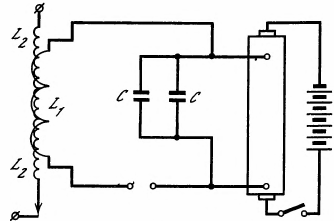
Tesla's resonant transformer (1990s). Switching circuit in the generator of electromagnetic waves
Rumkorf's high voltage induction coil is discharged into the Leyden jar. The latter is charged to a high voltage and then discharged through the primary winding of the resonant transformer. At the same time, a very high voltage occurs on its secondary winding tuned in resonance with the primary. Tesla receives high voltages (about 100 kV) with a frequency of about 150 kHz. These voltages caused a breakthrough in the air in the form of a brush discharge up to several meters long.

